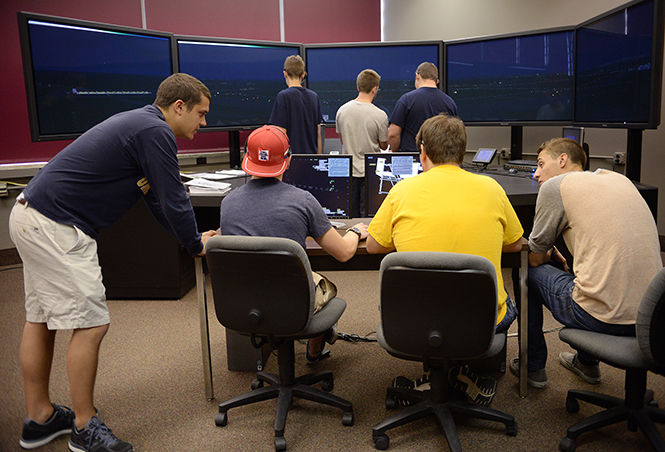Navigating the clouds
September 9, 2014
Their eyes see everything from the tall tower that overlooks the airport. They watch as the pilot navigates the aircraft from taxiway to taxiway. The aircraft finds its destination runway, and the pilot prepares for takeoff.
Air traffic controllers are the men and women whose eyes scan the airport landscape from the tower above. They scan for planes in the sky and on the ground. They’re aircraft movement coordinators, and their job is to safely direct pilots to their runways, prevent planes from crashing in aerospace and to deliver aircrafts from one controller to the next.
Around 300 students are currently pursuing a degree in aeronautics with a concentration in air traffic control at Kent State University. KSU’s air traffic control program was established in 2008, and has become well known over the years. Jonathan Rebman, recent graduate and teaching assistant for one of KSU’s air traffic control labs, said Kent has one of the best air traffic control programs in the United States.
“There aren’t many schools that offer an air traffic control program,” Rebman said. “You either go here or Miami.”
KSU prepares students for real world air traffic control jobs by providing them with access to the aeronautics lab in Van Deusen Hall. The lab is equipped with around $3 million worth of computers and software. Students operate a simulation of an airport called the “Academy Airport,” and practice “what if” situations to prepare for an air traffic control position after college.
There are four different controlling positions: ground, local, center and tracon. Ground controls the side roads (taxiways) that lead to the runway, local controls from the tower and scans the sky to let the pilots know when it’s safe to take off and land, tracon has control of planes for a 40 to 50 mile radius around an airport and center controls all of the planes in aerospace. KSU students studying air traffic control learn the ins and outs of all of these positions. Their final course in pursuing their degree is a course called “Capstone.” Students practice controlling as a group in their Capstone course. A student controls at each of the four positions, and the controllers communicate through headsets, just like actual air traffic controllers do.
After passing the Capstone course and graduating from KSU, students can’t start working at an airport until they complete training at the Federal Aviation Administration (FAA) Academy in Oklahoma. Controllers must pass a series of tests, and receive airport certification from the FAA, before searching for an actual job as a controller at an airport.
Air traffic controllers have a stressful job. The lives of many are in the palm of their hands, and they have one shot to get it right. Students learn this aspect of the job through their simulation training at KSU. Eric Bradt, senior aeronautics major with a concentration in air traffic control, said one of the most stressful parts of the job is sequencing planes for takeoff and landing.
“Sometimes, there’s a lot of traffic, and you have to squeeze planes in-between each other,” Bradt said. “It can definitely become a bit overwhelming at times.
Many people try to stay away from stressful jobs, but it might be a different story if the job pays well. According to the Bureau of Labor Statistics, air traffic controllers make up to $112,530 per year. That’s around $53 per hour. Air traffic controllers also have a fairly young retirement age. Controllers have to retire by the age of 56 because of the physical declines that usually come with aging. Most people’s eyes get worse as they age, and air traffic controllers are required to have excellent eyesight.
Kent State University’s mission statement for the air traffic control concentration states that they strive to prepare students for training at Oklahoma, and they expect their graduates to leave the university with an understanding of air traffic control positions and policies. KSU takes the time and budget to provide students with proper training.
Contact Danielle Hess at [email protected].












